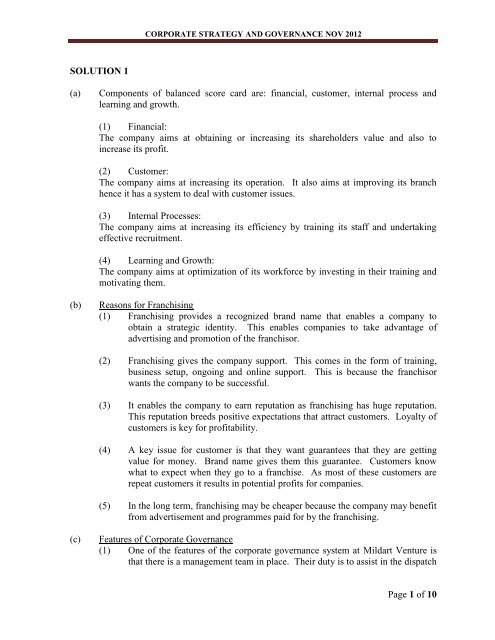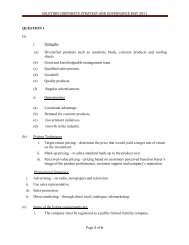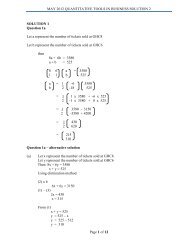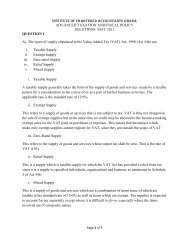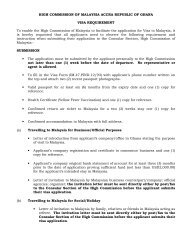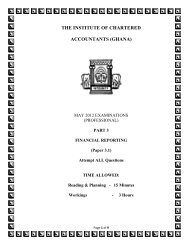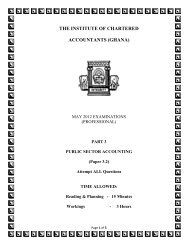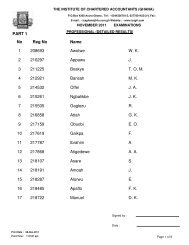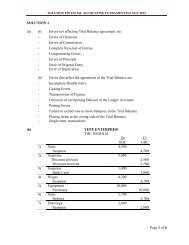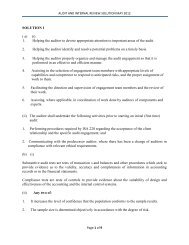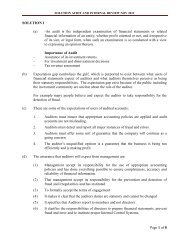CORPORATE STRATEGY AND GOVERNANCE.pdf
CORPORATE STRATEGY AND GOVERNANCE.pdf
CORPORATE STRATEGY AND GOVERNANCE.pdf
Create successful ePaper yourself
Turn your PDF publications into a flip-book with our unique Google optimized e-Paper software.
<strong>CORPORATE</strong> <strong>STRATEGY</strong> <strong>AND</strong> <strong>GOVERNANCE</strong> NOV 2012officials in government. This is because governments often define andregulate the behaviours of organisations.(6) Organisations which decide to take advantage of globalization would also haveto decide on their international product strategies – whether to serve the sameproduct to all markets (standardization) or to modify to suit the needs ofcustomers in the different countries (adaptation).(7) Access to technology and other resources. Globalization opens access toadvanced technologies, skills and other resources around the world. Corporatestrategic managers can therefore scout around for such resources in order toreduce their costs or improve their qualities.(8) Organisations that want to take advantage of globalization will have to haveappropriate policies for dealing with different exchange rates. Once tradingacross different countries, they have to be careful so as not to lose whileconverting from one currency to the other.(b)Organisations derive a number of benefits from practicing strategic managementconcepts appropriately.1. One of the most important benefit that accrues to organisation that use strategicmanagement is the increase in the level of profits. It is said that the analysis ofthe situation facing the organisation and the application of the right strategy(s)often leads to financial benefits.2. Another benefit that organisation get an understanding of environmentalthreats. Organisations awareness of threats posed by competitors, governmentregulations, change in economic indication enables management to prepareadequately.3. In the same way management is able to take advantage of opportunities that arerevealed through environmental analysis.4. Management is able to have a clear understanding of business.5. Implementation of strategy enables a more effective allocation of time andresource to identified opportunities.SOLUTION 6(a) (i) Working CapitalWorking capital is a financial measure which represents the operating liquidity of thecompany. It is calculated as current asset minus current liabilities. If a company’scurrent assets do not exceed or cover its current liabilities the company is going to runPage 7 of 10
<strong>CORPORATE</strong> <strong>STRATEGY</strong> <strong>AND</strong> <strong>GOVERNANCE</strong> NOV 2012into trouble. Such a company will not be in a position to pay back its creditors in theshort term.(ii)(a)(b)(c)Determinants of Working CapitalA determinant of working capital is the general nature and size of thecompany. For example manufacturing companies invest a lot in its fixed assetsas well as in current assets. Trading companies have to keep a lot of cash dueto the nature of their business. Retail shops must carry large stocks thereforethey have huge working capital.Another determinant of working capital is the growth objective of theorganisation. Growth oriented companies require more working capital thanthose that are static. As companies expands or grow their working capitalrequirements also increases. When a company is growing there is the need tobuy more inputs as raw materials, recruit more staff, among other purchases.During such period the company would witness an increase in both its assetsand liabilities activities.The availability of credit from suppliers has a bearing on the level of workingcapital that an organisation can keep. The credit terms given to businessdepends to an extent on the norms of the industry in which it is operating.Credit services from the banks also influence working capital. A company willkeep less working capital if it has access to liberal credit terms.(d) Another determinant of working capital is the auditing of supply. Anorganisation uses inventories as raw materials, spare parts to carry out itsproduction. The conditions of supply for these inventories affect the status ofits working capital. If the supply is prompt and adequate the organisation canmanage with small inventory. Also when the raw material is available onseasonal bases more funds are needed during the peak season.(e)The trade cycle also influences the level of working capital. Trade cycles refersto the periodic changes or turns in business opportunities. The cycle can havefour phases. These periods are boom, depression, recession and recovery.During a boom period, the organisation has to carry out more business animplication is more production requiring more working capital. Recessionperiod comes with less business activities hence less working capital.(f) Techniques to Support Change(1) A technique to support the change process is the creation of financial reserveswhich will be used to support employees that will be adversely affected by thechange. The change process may come with reduction in workforce due to theuse of other technologies that use less labour. The organisation has to paythese employees off so that the change processes do not face resistance.Page 8 of 10
<strong>CORPORATE</strong> <strong>STRATEGY</strong> <strong>AND</strong> <strong>GOVERNANCE</strong> NOV 2012(2) Another technique is for management to put in place a communication plan forthe change. It is important for management to ensure that employeesunderstand what the change is and why there is the need for the change. Theyshould also know how the change will be implemented. It is also important thtactivities are monitored and feedback given to staff.(3) Another technique is t prepare the staff to accept the change. This calls forhuman resource planning. Once gaps have been indentified staff should betrained. The aim is to provide employees with the skills, techniques, expertise,required for them to perform their role and duties effectively as the changes arebeing implemented.(4) The organisation should also encourage employee participation in the planningand implementation stages of the change process. This will get themcommitted to the change strategy.SOLUTION 7(a)A product life cycle describes the pattern of sales of a product over time. It istypically divided into four stages including introduction, growth, maturity and declineas shown below:The introductory stage is characterised by low sales because customers are unaware ofthe product or do not have confidence in it, sales rise steeply at the growth stage whenmore customers become aware of the product but gradually slows down and enters thematurity stage as a result of competition, new technology and change in customertastes. The decline stage …… when these factors overtake management efforts toincrease sales.The product life cycle concept is of importance to an organization in a number ofways.(i)The PLC concept enables an organisation to forecast the sales trend of itsproduct and to plan appropriately.Page 9 of 10
<strong>CORPORATE</strong> <strong>STRATEGY</strong> <strong>AND</strong> <strong>GOVERNANCE</strong> NOV 2012(ii)(iii)(iv)The concept also enables an organisation to study the activities of competitorsand to implement various strategies including innovation and advertising.An organisation also plans it expenditure knowing the various cost changesthat occur as the product moves through its life cycle.The factors responsible for the product life also challenge management to lookfor and exploit new market opportunities such as new markets, new uses of theproduct etc in order to increase sales.(b)(c)Policies are guidelines, rules and procedures used to implement strategy. There aremany uses f policies including the following:(i)(ii)They communicate specific guidelines for making decisions. Thus, they guidemanagement thinking on what can be done and what cannot be done.Policies also act as directives to employees regarding how activities must beperformed. This helps to optimize the use of resources.(iii) Policies also clarify what work is to be done by whom. They promotedelegation of decision making to appropriate managerial levels where variousproblems usually arise.(iv)(v)(vi)They mould manager and employee behaviour into something suitable for theachievement of organizational objectives.They offer predetermined answers to routine problems thereby expeditingaction on both ordinary and extra ordinary problem.Policies reduce resistance to or rejection of chosen strategies.Page 10 of 10


